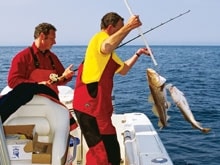
|| |—| || |Ned Kittredge, right, helps boat a double-header of Provincetown cod. | When someone mentions cod fishing off New England, most anglers think of predawn departures, wintry weather, distant runs to deepwater banks, slow-moving party boats and huge sinkers and jigs. It’s a sport enjoyed by hardy Yankees willing to endure freezing conditions and sleep deprivation to crank in hundreds of feet of heavy mono with bulky reels attached to broomstick-thick rods. But the fantastic inshore trip I took one warm spring day last May changed my thinking.
One morning late in the month, Captain Ned Kittredge, three friends and I launched his new 33-foot center console at Plymouth, Massachusetts, for the 20-mile run to Provincetown (a.k.a P-Town) at the tip of Cape Cod. Leaving the harbor, we idled past the docked Mayflower and Plymouth Rock, gave them an appreciative look and headed east. The light wind, bright sun and 68-degree temperature were far different from the traditional Northeast cod fishing conditions any of us knew.
The high-horsepower run across Cape Cod Bay didn’t take long on glass seas, and as we came within sight of the beach all the signs were there: Flocks of birds working over baitfish schools, and periodic dense fish marks showed promise on the color depthfinder. Better yet, only a handful of private boats worked one piece of ground, and except for a whale-watching boat, we had the ocean to ourselves.
A SPECIAL PIECE OF WATER
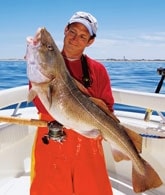
| |STEAKER COD in the 20- to 30-pound range help fill the fishbox quickly. Best time to take advantage of this unusual New England fishery is in May.| The Provincetown grounds, which lie within only a mile of the beach in relatively shallow water, are particularly appealing to codfish because of the shoals and currents that form off the north shore. These features attract forage such as whiting, mackerel, herring, squid and sand lances, all of which draw and hold predatory fish.
About a mile offshore, Kittredge idled the boat along in lazy circles and studied his electronics. Meanwhile, the rest of us peeled off our windbreakers and feverishly rigged tackle. When Kittredge found a spot he liked in about 85 feet of water, he cut the triple outboards. Soon five sets of lures were sent plummeting into the steely-green current.
“I’m on,” shouted Derek DeSantis as he lifted hard against the light rod. “It feels like a keeper.”
“Mine is definitely a keeper,” said Captain Alex Malgieri as he swung a 15-pounder aboard to beat DeSantis and claim the first fish of the trip. “Looks like we hit the spot just right.”
Soon our other three rods were bent with good fish. But the big ones were yet to come.
STOP AT THE BAR
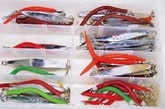
| |TERMINAL GEAR consists predomi-nantly of diamond jigs and soft-plastic teasers. Sharpies replace trebles with single hooks to avoid hanging bottom.| May is the best month to fish the spring cod run off Provincetown, and the bite usually lasts into June. One of the keys to finding cod is the proper water temperature, which signals the arrival of forage species. Kittredge says readings of 48 degrees or higher are the preferred temperatures for herring and mackerel, and that’s his main consideration when planning an early trip.
“Once I’m on the grounds,” he said, “I look for a lot of bird life such as northern gannets, cormorants and gulls working over baitfish in anywhere from 50 to 200 feet of water. If you’re in the right spot, you can often see the sand lances near the surface. I also look for bait and target species on the depthfinder. Areas of fast current tend to congregate bait and hence the cod and pollock. Try the nearshore rips in 45-plus feet of water, which are less than three-quarters of a mile from shore.”
One of the better areas is a mile offshore just before the west end of Peaked Hill Bar. Watch your recorder for the spots where the water drops from 45 to 80 feet deep. As you fish your way along Peaked Hill, you’ll find lobster buoys in the 50-foot depths.
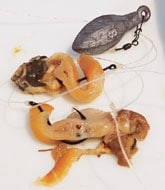
| |FINICKY COD require special tactics. Clams fished on a simple high-low rig turn on jig-shy cod unless dogfish spoil the party.| Malgieri says Peaked Hill Bar, easily seen on a chart, is approximately five miles long and fish can be found anywhere along its length. You can work out toward the deeper water to the north and east heading toward the R “2PH” buoy, which is about three miles from shore. This area can hold fish at any depth where bait is concentrated.
“Try looking around the lobster gear for fish,” says Malgieri, who has been catching cod for more than 20 years. “Sometimes they’re stacked up in the shallow water. The challenge is setting up a good drift to avoid getting hung up on the pot lines. If you’re not ready to this, stay out of the area and work the deeper side of the bar just outside the trap line.”
Another hotspot that Malgieri and Kittredge suggest is the remnants of an old wreck approximately one mile west of the R “2PH” buoy. Much of the wreck’s structure gives only subtle returns on your depthfinder. Cod often concentrate in small areas here so be prepared for short drifts, possibly with other boats close by.
P-Town’s total fishable area is large and extends from “Wood End” near the entrance to Provincetown Harbor around the entire tip of Cape Cod to the stone tower at the North Truro Highlands. Hang-ups on this bottom are rare because of its hard, shifting sand with scattered gravel composition.
TURNING THE TACKLE
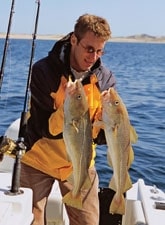
| |Water temperature in the upper 40-degree range signals the start of good fishing. Key on working birds and rips in 45 to 200 feet of water.| The most efficient way to catch these cod is with diamond jigs and soft-plastic teasers. Kittredge modifies his diamonds by removing the treble hook and attaching a No. 8 stainless steel split ring followed by a Bead Chain 131 swivel and a single Mustad 31022 9/0 or 10/0 Limerick hook.
“Leaving the treble hooks on the jigs,” says Kittredge, “may give you more hook-ups, but there is also a far greater chance of hanging on bottom or lobster gear with treble hooks, and they make it harder to unhook and release small fish.”
The single hook is dressed with a piece of red latex tubing long enough to extend a few inches past the bend. Tubing is extremely effective because it resembles a sand lance, a primary food of the cod. The bead chain allows the hook and tube to spin enticingly when retrieved.
Using an 80-pound monofilament leader, Kittredge ties in a blood knot about 18 inches above the jig to attach the teaser. He then clips off one tag end close to the knot. On the other end, which is about six inches long, he clinches on a Red Gill, Delta Eel or Felmlee Eel. The teaser is rigged on an Owner Cutting Point SSW 6/0 hook. Kittredge prefers a knot to a three-way swivel because hardware fouls droppers and impairs their presentation. The rig is finished with a barrel swivel between the main line and the leader.
YO-YO TRICKS
One popular codfishing method is called “yo-yo” jigging. After free-spooling your diamond to the bottom, take a couple of turns to clear any hang-ups and then lift the rod tip with brisk “snapping” motions. Cod will frequently strike the lures when they flutter to the bottom as the rod drops, so be prepared to set the hook.
“Squidding” is another productive method. This technique involves dropping the lure to the bottom, taking about ten slow turns up and repeating the process. The action allows the tube on the teaser-and-jig to swim or spin seductively and will often prompt lazy cod into striking.
On rare occasions cod can turn finicky, and for that reason top captains recommend carrying a container of frozen shucked clams. A simple high-low rig using two 8/0 hooks and an eight-ounce bank sinker rigged on 80-pound leader is good insurance against off days when cod shun jigs. The major drawback to baitfishing is that it attracts spiny dogfish. If you get into the dogs you’ll need to move to a new spot.
LIGHT FIGHTS
The use of lighter tackle has made Northeast bottom fishing more challenging thanks to the introduction of superbraid line, which features low stretch, high sensitivity and thinner diameter. In deep-water areas that were once only fishable with 12- to 20-ounce sinkers and jigs, you can now routinely use just six to eight ounces.
|| |—| |If You Go To Book A Trip Capt. Ned Kittredge E-mail: kittredge65@comcast.net Phone: (508) 998-7965Capt. Alex Malgieri E-mail: 29topaz@comcast.net Phone: (508) 561-5629Capt. John Walker Website: www.saltwaterunlimited.net Phone: (617) 413-3473Walsh’s Fishing Website: www.walshsfishing.com Phone: (781) 592-0017 Andy Lynn Boats Website: www.andylynnboats.com Phone: (508) 746-7776| A sporting, all-purpose bottomfish outfit consists of a 6 1/2- to 7-foot, medium-heavy boat rod rated for 17- to 40-pound line. Match the rod to a high-quality 3/0 levelwind reel like a Shimano or Penn. Spool your reel with 25-pound Dacron backing and then top-shoot it with 150 yards of 30-pound superbraid.
When you get into a pod of big cod in 100 feet of water as we did toward the end of our trip last May, the action really heats up. The 20- to 25-pounders caused plenty of excitement onboard. My last fish, a 35-pound steaker, was the biggest of the trip and earned me bragging rights for the day. The fat cod made for great sport on light tackle. Anglers are allowed 10 cod in possession and fish must measure more than 22 inches.
Soon the fishbox was full, an onshore breeze was coming up and it was time to run home.
“It doesn’t get much better than that,” I said to Kittredge as he fired up the motors, while the rest of us stowed the gear.
“Yeah,” he said, “we’ve got a lot of filleting to do tonight. But I can’t wait for our next trip. What are you doing tomorrow?”
| COD ON YOUR OWN For information on ramps and more details, see Public Access to the Waters of Massachusetts, available at DFWELE offices or from the Massachusetts Public Access Board, 1440 Soldier’s Field Road, Brighton, MA 02135, (617) 727-1843 or www.state.ma.us/dfwele/pab/pabbook.htm |









